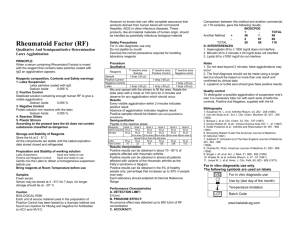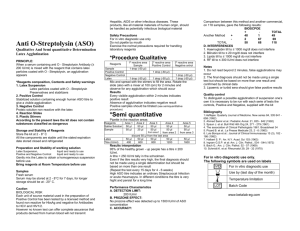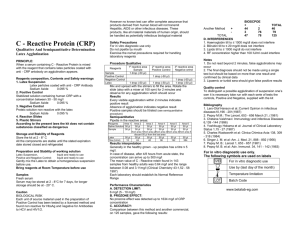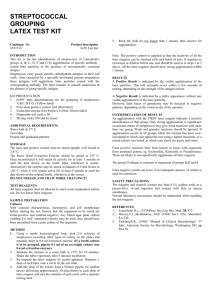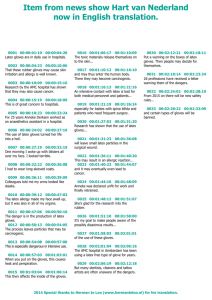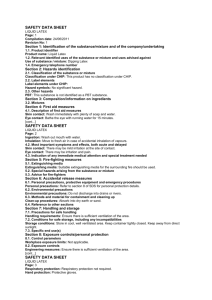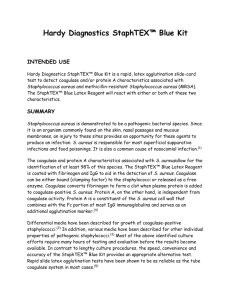KAtex training notes
advertisement
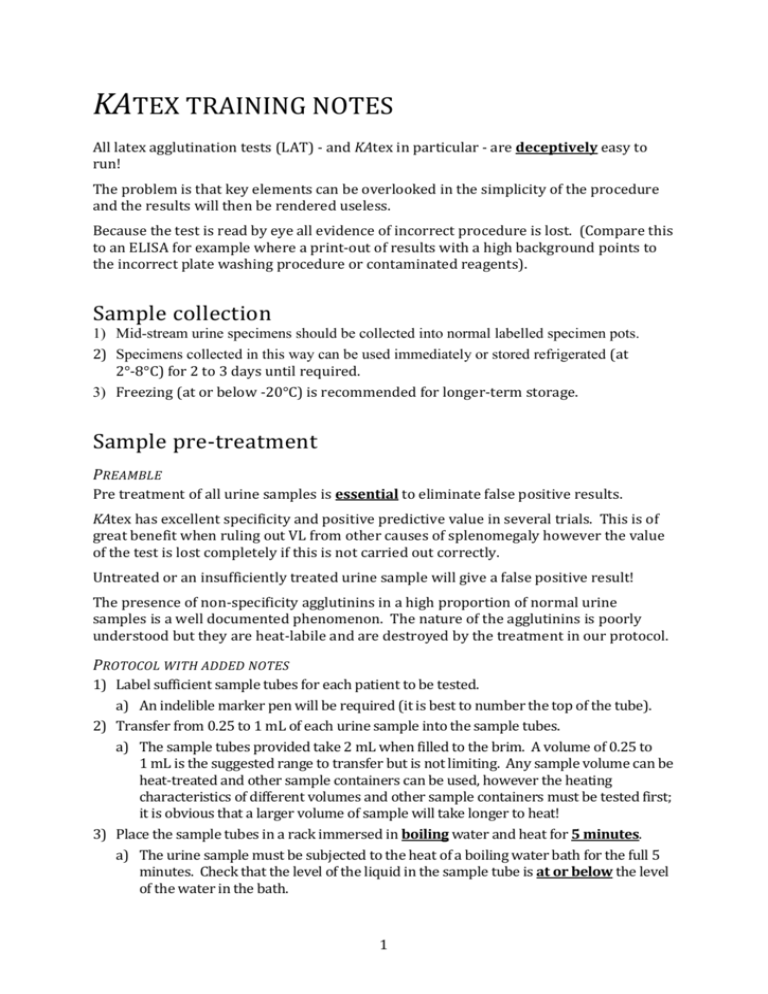
KATEX TRAINING NOTES All latex agglutination tests (LAT) - and KAtex in particular - are deceptively easy to run! The problem is that key elements can be overlooked in the simplicity of the procedure and the results will then be rendered useless. Because the test is read by eye all evidence of incorrect procedure is lost. (Compare this to an ELISA for example where a print-out of results with a high background points to the incorrect plate washing procedure or contaminated reagents). Sample collection 1) Mid-stream urine specimens should be collected into normal labelled specimen pots. 2) Specimens collected in this way can be used immediately or stored refrigerated (at 2°-8°C) for 2 to 3 days until required. 3) Freezing (at or below -20°C) is recommended for longer-term storage. Sample pre-treatment PREAMBLE Pre treatment of all urine samples is essential to eliminate false positive results. KAtex has excellent specificity and positive predictive value in several trials. This is of great benefit when ruling out VL from other causes of splenomegaly however the value of the test is lost completely if this is not carried out correctly. Untreated or an insufficiently treated urine sample will give a false positive result! The presence of non-specificity agglutinins in a high proportion of normal urine samples is a well documented phenomenon. The nature of the agglutinins is poorly understood but they are heat-labile and are destroyed by the treatment in our protocol. PROTOCOL WITH ADDED NOTES 1) Label sufficient sample tubes for each patient to be tested. a) An indelible marker pen will be required (it is best to number the top of the tube). 2) Transfer from 0.25 to 1 mL of each urine sample into the sample tubes. a) The sample tubes provided take 2 mL when filled to the brim. A volume of 0.25 to 1 mL is the suggested range to transfer but is not limiting. Any sample volume can be heat-treated and other sample containers can be used, however the heating characteristics of different volumes and other sample containers must be tested first; it is obvious that a larger volume of sample will take longer to heat! 3) Place the sample tubes in a rack immersed in boiling water and heat for 5 minutes. a) The urine sample must be subjected to the heat of a boiling water bath for the full 5 minutes. Check that the level of the liquid in the sample tube is at or below the level of the water in the bath. 1 b) Do not hurry this step. The VL urinary antigen is not heat labile, so if in doubt heat for longer. 4) Allow the samples to cool to ambient temperature before performing the test. a) This only takes 5 – 10 minutes if the recommended tubes and sample size are used. Latex test PREAMBLE The latex agglutination reaction depends not only on antibody-antigen binding but also on electrostatic charges present on the Test Latex. Factors that affect this charge can change the performance of the test. This is most clearly seen if the Test Latex is accidentally frozen. On freezing, the latex particles are brought too close together leading to disruption of close-range repulsive forces acting on the particles and causing irreversible clumping of the reagent. A less obvious cause might arise from temperature differences in the reagents. See below! PROTOCOL WITH ADDED NOTES 1) Bring all reagents to the ambient temperature. a) Test Latex straight from the Fridge is a different reagent to Test Latex at ambient temperature! b) Placing a drop of cold Test Latex on the slide does not give the same performance as Test Latex brought properly to the ambient temperature even though it will have reached the ambient temperature on the slide after 2 minutes. 2) Shake the Test Latex well immediately before use. a) The Latex settles on standing! b) Shake the dropper bottle before each and every use! c) In the worst case a pellet of latex will remain unused in the bottom of the dropper bottle but any incomplete mixing will mean the concentration of the latex changes over the use of the kit. This will affect both the speed of reaction and the sensitivity of the test. 3) Add 50 µL of the treated urine sample to a reaction zone on the glass slide. a) Procedural Note: run the Negative Control in a reaction zone next to the test sample(s) to distinguish between a weak positive and negative result. One drop is equivalent to the 50 µL sample volume b) Procedural Note: periodically run the Positive Control to check the performance of the Test Latex. It is recommended to run the Positive Control the first time the kit is used and periodically when removed from storage. One drop is equivalent to the 50 µL sample volume. 4) Add one drop of Test Latex a) Hold the dropper bottle up-side-down and vertically over the reaction zone to ensure that the correct volume (approximately 40 µL) is dispensed. 5) Stir both liquids to a completely homogenous mixture that covers the whole surface of the reaction zone. 2 a) If the liquid is not spread out to fill the blue ring of the reaction zone, the depth of the (white and opaque) liquid will be too high and you will not be able to see a weak agglutination against the black background. 6) Tilt the glass slide with a rotating action - clockwise and anticlockwise - continuously for two minutes. a) The speed of the reaction will be slow and a weak agglutination will not be visible after 2 minutes if the liquid is not mixed properly. 7) After 2 minutes, read the degree of agglutination obtained. a) Any degree of agglutination (graininess) that can be seen compared to the Negative Control should be read as positive (+). b) Side lighting arranged so that light enters the reaction zone at an acute angle can make it easier to read the test result. For example, with the use of an electric desk lamp or else sunlight entering through a door held ajar into a (relatively) darker room. c) Procedural Note: It is important to read the negative control and all test samples after the same reaction time of two minutes. In some latex agglutination tests the negative control can take on a slightly grainy appearance. It is therefore Good Practice to run a negative control under the same conditions as the test sample. That being said, KAtex does not have this problem. When run correctly, the Negative Control test remains homogeneous, with a smooth milky-white appearance. INTERPRETATION negative (-) No agglutination compared to negative control. positive (+) Agglutination can just be discerned when compared to the negative control (weak positive). positive (++) Agglutinated particles can clearly be seen against a background of granular latex. positive (+++) The latex has agglutinated and much has collected around the edge of the reaction zone (strong positive). Finishing 1) The reagents (Test Latex, Positive Control and Negative Control) are all reasonably stable. They can be kept at ambient temperature during the day while in use but should be stored refrigerated (2° - 8°C) when not required. 2) The glass slide should be disinfected (if necessary) and rinsed in cleaned tap water and polished with a paper towel after the completion of every test. 3) The wooden mixing sticks are single use and should be disinfected and disposed of together with any disposable micropipette tips that have been used in a safe manner 4) The samples of boiled urine can either be disinfected and disposed of as above or retained for repeat testing if required. Appropriately labelled boiled urine samples can be stored in the same manner as fresh samples (as detailed in the first section). 3
